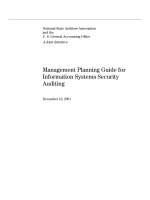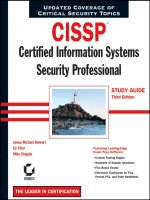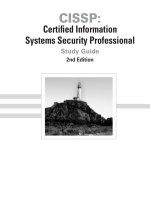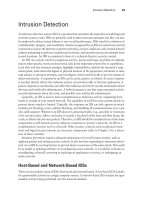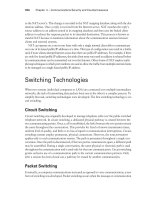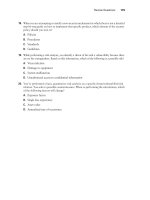Lecture Information systems security - Chapter 8: Conducting security audits
Bạn đang xem bản rút gọn của tài liệu. Xem và tải ngay bản đầy đủ của tài liệu tại đây (711.44 KB, 46 trang )
Conducting Security Audits
Contents
v
Define privilege audits
v
Describe how usage audits can protect security
v
List the methodologies used for monitoring to detect
security-related anomalies
v
Describe the different monitoring tools
Privilege Auditing
v
A privilege can be considered a subject’s access level
over an object
v
Principle of least privilege
v Users should be given only the minimal amount of privileges
necessary to perform his or her job function
v
Privilege auditing
v Reviewing a subject’s privileges over an object
v Requires
knowledge of privilege management, how
privileges are assigned, and how to audit these security
settings
Privilege Management
v
The process of assigning and revoking privileges to
objects
v
The roles of owners and custodians are generally wellestablished
v
The responsibility for privilege management can be either
centralized or decentralized
Centralized and Decentralized
Structures
v
In a centralized structure
v One unit is responsible for all aspects of assigning or
revoking privileges
v All custodians are part of that unit
v Promotes uniform security policies
v Slows response, frustrates users
v
A decentralized organizational structure for privilege
management
v Delegates the authority for assigning or revoking privileges
more closely to the geographic location or end user
v Requires IT staff at each location to manage privileges
Assigning Privileges
v
The foundation for assigning privileges
v The existing access control model for the hardware or
software being used
v
Recall that there are four major access control models:
v Mandatory Access Control (MAC)
v Discretionary Access Control (DAC)
v Role Based Access Control (RBAC)
v Rule Based Access Control (RBAC)
Auditing System Security Settings
v
Auditing system security settings for user privileges
involves:
v A regular review of user access and rights
v Using group policies
v Implementing storage and retention policies
v
User access and rights review
v It is important to periodically review user access privileges
and rights
v Most organizations have a written policy that mandates
regular reviews
Auditing System Security Settings
User Access and Rights Review
(continued)
v
Reviewing user access rights for logging into the network
can be performed on the network server
v
Reviewing user permissions over objects can be viewed
on the network server
User Access and Rights Review
(continued)
Group Policies
v
Instead of setting the same configuration baseline on each
computer, a security template can be created
v
Security template
v A method to configure a suite of baseline security settings
v
On a Microsoft Windows computer, one method to deploy
security templates is to use Group Policies
vA
feature that provides centralized management and
configuration of computers and remote users who are using
Active Directory (AD)
Group Policy Objects (GPOs)
v
The individual elements or settings within group policies
are known as Group Policy Objects (GPOs).
v
GPOs are a defined collection of available settings that
can be applied to user objects or AD computers
v
Settings are manipulated using administrative template
files that are included within the GPO
Storage and Retention Policies
v
Health Insurance
(HIPPA)
v
Sarbanes-Oxley Act
Portability
and Accountability Act
v Require organizations to store data for specified time periods
v Require data to be stored securely
HIPPA Sanction for Unlocked Dumpsters
Information Lifecycle Management
(ILM)
v
A set of strategies for administering, maintaining, and
managing computer storage systems in order to retain
data
v
ILM strategies are typically recorded in storage and
retention policies
v Which outline the requirements for data storage
v
Data classification
v Assigns
a level of business importance, availability,
sensitivity, security and regulation requirements to data
Data Categories
Data Categories
v
Grouping data into categories often requires the
assistance of the users who save and retrieve the data on
a regular basis
v
The next step is to assign the data to different levels or
“tiers” of storage and accessibility
Contents
v
Define privilege audits
v
Describe how usage audits can protect security
v
List the methodologies used for monitoring to detect
security-related anomalies
v
Describe the different monitoring tools
Usage Auditing
v
Audits what objects a user has actually accessed
v
Involves an examination of which subjects are accessing
specific objects and how frequently
v
Sometimes access privileges can be very complex
v
Usage auditing can help reveal incorrect permissions
v
Inheritance
v Permissions given to a higher level “parent” will also be
inherited by a lower level “child”
v
Inheritance becomes more complicated with GPOs
Privilege Inheritance
GPO Inheritance
v
GPO inheritance
v Allows administrators to set a base security policy that
applies to all users in the Microsoft AD
v
Other administrators can apply more specific policies at a
lower level
v That apply only to subsets of users or computers
v
GPOs that are inherited from parent containers are
processed first
v Followed by the order that policies were linked to a container
object
Log Management
v
A log is a record of events that occur
v
Logs are composed of log entries
v
Each entry contains information related to a specific event
that has occurred
v
Logs have been used primarily for troubleshooting
problems
v
Log management
v
The process for generating, transmitting, storing,
analyzing, and disposing of computer security log data
Application and Hardware Logs
v
Security application logs
v Antivirus software
v Remote Access Software
v Automated patch update service
v
Security hardware logs
v Network intrusion detection systems and host and network
intrusion prevention systems
v Domain Name System (DNS)
v Authentication servers
v Proxy servers
Antivirus Logs
